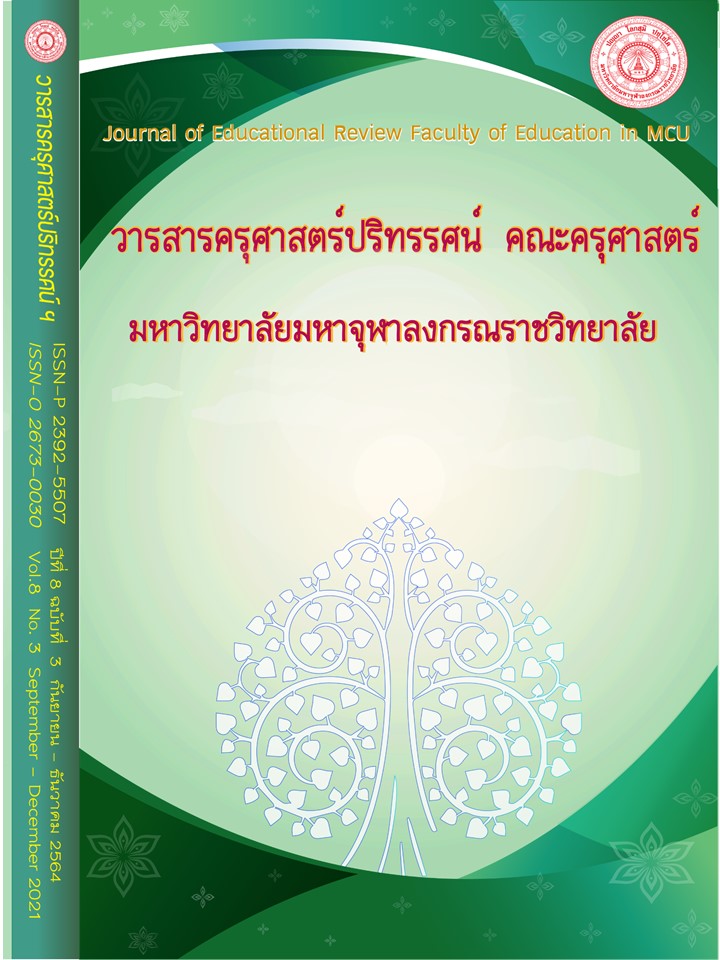THE DEVELOPMENT OF ACADEMIC ACHIEVEMENT IN THE SCIENCE OF SIMPLE MACHINES BY THE 5Es OF INQUIRY-BASED LEARNING OF SECONDARY EDUCATION YEAR 2 STUDENTS
Main Article Content
Abstract
This research article to identify progress in the science of simple machines by the 5Es of inquiry-based learning of secondary education year 2 students, To compare the academic achievement and satisfaction of secondary education year 2 in the science of simple machines of secondary education year 2 students who learn by using the 5Es of inquiry-based learning and who learn by using conventional learning. The samples used in the experiment were secondary education year 2 students of Sainoi Secondary School, Sainoi district in Nonthaburi Province. used to select the sample in 3 classrooms, totally 126 students. The instruments used for data collection consisted of (1) 5Es model of learning management, (2) Learning achievement test and (3) Student satisfaction survey. Statistics for data analysis were percentage, mean, standard deviation and t-test. The finding from the study revealed that (1) The science of simple machines by the 5Es of inquiry-based learning of secondary education year 2 students could develop the learning progress in the science at a high level, accounted for 73.02% which was in harmony with the set hypothesis, (2) The academic achievement and satisfaction of secondary education year 2 students by the 5Es of inquiry-based learning was higher than the science by the conventional learning of secondary education year 2 students, with the statistical significance level of 0.01
Article Details
ทัศนะและความคิดเห็นที่ปรากฏในบทความในวารสารฉบับนี้ถือเป็นความรับผิดชอบของผู้เขียนบทความนั้นเพียงผู้เดียว และไม่ถือเป็นทัศนะและความรับผิดชอบของกองบรรณาธิการ
กองบรรณาธิการขอสงวนสิทธิ์ในการคัดเลือกบทความลงตีพิมพ์และจะแจ้งให้เจ้าของบทความทราบหลังจากผู้ประเมินบทความตรวจอ่านบทความแล้ว
ต้นฉบับที่ได้รับการตีพิมพ์ในวารสารครุศาสตร์ปริทรรศน์ คณะครุศาสตร์ มหาวิทยาลัยมหาจุฬาลงกรณราชวิทยาลัย ถือเป็นกรรมสิทธิ์ของคณะครุศาสตร์ มหาวิทยาลัยมหาจุฬาลงกรณราชวิทยาลัย ห้ามนำข้อความทั้งหมดหรือบางส่วนไปพิมพ์ซ้ำ เว้นเสียแต่ว่าจะได้รับอนุญาตจากมหาวิทยาลัยฯ เป็นลายลักษณ์อักษร
References
กรมวิชาการ. (2546). พระราชบัญญัติการศึกษาแห่งชาติ พ.ศ.2542 และแก้ไขเพิ่มเติม (พ.ศ. 2543 และ พ.ศ. 2553). กรุงเทพมหานคร: โรงพิมพ์อักษรไทย.
กระทรวงศึกษาธิการ. (2560). หลักสูตรแกนกลางการศึกษาขั้นพื้นฐาน พุทธศักราช 2551 (ฉบับปรับปรุง พ.ศ. 2560). กรุงเทพมหานคร: โรงพิมพ์ชุมนุมสหกรณ์เกษตรแห่งประเทศไทย.
กุณฑรี เพ็ชรทวีพรเดช และคณะ (2550). สุดยอดวิธีสอนวิทยาศาสตร์นำไปสู่การจัดการเรียนรู้ของครูยุคใหม่. กรุงเทพมหานคร: อักษรเจริญทัศน์.
จิราภรณ์ คงหนองลาน และเฉลิมพร ทองพูน (2557). การพัฒนาชุดกิจกรรมการเรียนรู้ตามกระบวนการสืบเสาะหาความรู้ตามวงจรการเรียนรู้แบบ 7E วิชาเคมีเพิ่มเตอม เรื่อสารละลาย สำหรับนักเรียนชั้นมัธยมศึกษาปีที่ 5. สักทอง: วารสารมนุษยศาสตร์และสังคมศาสตร์. 20(3).
ธีรศักดิ์ อุ่นอารมณ์เลิศ. (2554). วิธีวิทยาการวิจัยทางสังคมศาสตร์. นครปฐม: โรงพิมพ์มหาวิทยาลัยศิลปากร
บุญชม ศรีสะอาด. (2542). วิธีการทางสถิติสำหรับการวิจัย. พิมพ์ครั้งที่ 2. กรุงเทพมหานคร: สุวีริยาสาส์น.
สำนักคณะกรรมการการศึกษาขั้นพื้นฐาน. (2562). ผลการทดสอบทางการศึกษาระดับชาติพื้นฐาน (O-NET) ปีการศึกษา 2562. แหล่งที่มา https://bet.obec.go.th/New2020/wp-content/uploads/2020/06/onet-p3m3m62562.pdf. สืบค้นเมื่อ วันที่ 24 ม.ค. 2564.
สุวธิดา ล้านสา. (2558). การพัฒนาชุดกิจกรรมการเรียนรู้ โดยใช้กระบวนการสืบเสาะหาความรู้ เพื่อส่งเสริมความสามารถในการคิดวิเคราะห์และจิตวิทยาศาสตร์ สำหรับนักเรียนชั้นประถมศึกษาปีที่ 4. วิทยานิพนธ์ศึกษาศาสตรมหาบัณฑิต. มหาวิทยาลัยศิลปากร.


